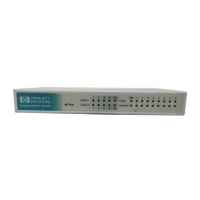156
3. Configure the SPF
calculation interval.
timer spf
maximum-interval
[ minimum-interval
[ incremental-interval ] ]
By default:
• The maximum interval is
5 seconds.
• The minimum interval is
50 milliseconds.
• The incremental interval
is 200 milliseconds.
Configuring convergence priorities for specific routes
A topology change causes IS-IS routing convergence. To improve convergence speed, you can
assign convergence priorities to IS-IS routes. Convergence priority levels are critical, high, medium,
and low. The higher the convergence priority, the faster the convergence speed.
By default, IS-IS host routes have medium convergence priority, and other IS-IS routes have low
convergence priority.
To assign convergence priorities to specific IS-IS routes:
1. Enter system view.
N/A
2. Enter IS-IS IPv4 unicast
address family view.
a isis [ process-id ] [ vpn-instance
vpn-instance-name ]
b cost-style { wide | wide-compatible }
c address-family ipv4 [ unicast ]
N/A
3. Assign convergence
priorities to specific IS-IS
routes.
• Method 1:
prefix-priority { critical | high |
medium } { prefix-list prefix-list-name |
tag tag-value }
• Method 2:
prefix-priority route-policy
route-policy-name
By default, IS-IS
routes, except IS-IS
host routes, have the
low convergence
priority.
Setting the LSDB overload bit
By setting the overload bit in sent LSPs, a router informs other routers of failures that make it unable
to select routes and forward packets.
When an IS-IS router cannot record the complete LSDB, for example, because of memory
insufficiency, it will calculate wrong routes. To make troubleshooting easier, temporarily isolate the
router from the IS-IS network by setting the overload bit.
To set the LSDB overload bit:
1. Enter system view.
system-view
N/A
2. Enter IS-IS view.
isis
[ process-id ] [
vpn-instance
vpn-instance-name ]
N/A

